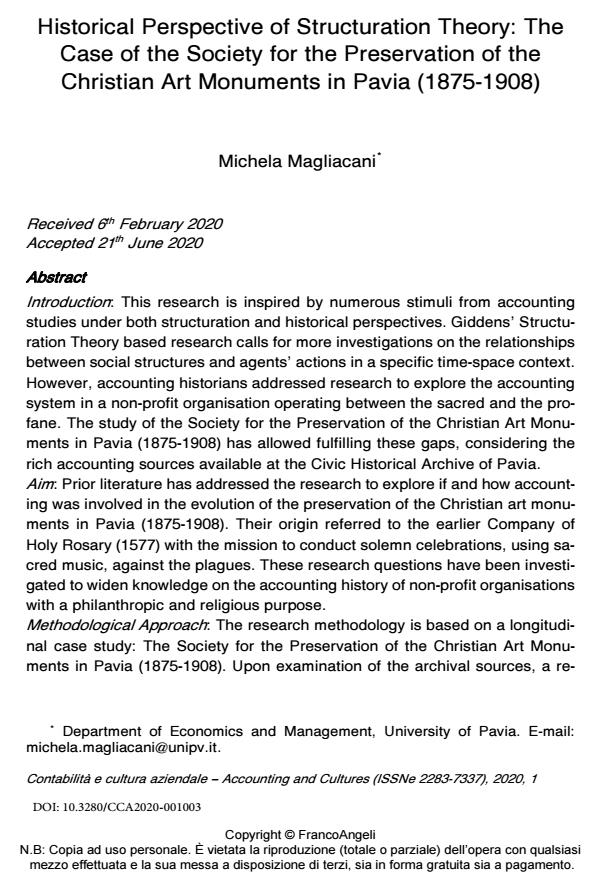Historical Perspective of Structuration Theory: The Case of the Society for the Preservation of the Christian Art Monuments in Pavia (1875-1908)
Journal title CONTABILITÀ E CULTURA AZIENDALE
Author/s Michela Magliacani
Publishing Year 2020 Issue 2020/1
Language English Pages 24 P. 33-56 File size 219 KB
DOI 10.3280/CCA2020-001003
DOI is like a bar code for intellectual property: to have more infomation
click here
Below, you can see the article first page
If you want to buy this article in PDF format, you can do it, following the instructions to buy download credits

FrancoAngeli is member of Publishers International Linking Association, Inc (PILA), a not-for-profit association which run the CrossRef service enabling links to and from online scholarly content.
Introduction: This research is inspired by numerous stimuli from accounting studies under both structuration and historical perspectives. Giddens’ Structuration Theory based research calls for more investigations on the relationships between social structures and agents’ actions in a specific time-space context. However, accounting historians addressed research to explore the accounting system in a non-profit organisation operating between the sacred and the profane. The study of the Society for the Preservation of the Christian Art Monuments in Pavia (1875-1908) has allowed fulfilling these gaps, considering the rich accounting sources available at the Civic Historical Archive of Pavia. Aim: Prior literature has addressed the research to explore if and how accounting was involved in the evolution of the preservation of the Christian art monuments in Pavia (1875-1908). Their origin referred to the earlier Company of Holy Rosary (1577) with the mission to conduct solemn celebrations, using sacred music, against the plagues. These research questions have been investigated to widen knowledge on the accounting history of non-profit organisations with a philanthropic and religious purpose. Methodological Approach: The research methodology is based on a longitudinal case study: The Society for the Preservation of the Christian Art Monuments in Pavia (1875-1908). Upon examination of the archival sources, a reconstruction of the history of the Society based on the contextual, and institutional and organisational changes as been attempted. The Structuration Theory has been adopted to interpret the accounting sources. Moreover, the synchronic approach has enabled the development of critical analysis, considering the trend of accounting knowledge during the period of this study. Main Findings: The research findings highlight the traits of continuity and changes in accounting with the contextual and institutional or organisational evolution of the Society. Accounting has contributed to the resilience and relevance of this organisation. The traits of changes, connected to the structural dimensions of accounting, enabled the accountability of information on the Society. This legitimised its philanthropic mission and strengthened the accounting domination, secularly than ecclesiastic. The research highlights how the double facade of accounting guaranteed the Society’s resilience by fulfilling both technical and spiritual objectives during its long-existence. Originality: The Society for the Preservation of the Christian Art Monuments in Pavia has never been studied from the perspective of accounting history. This research bridges the gap in the history of the Society whose existence over the centuries has been questioned. From the Structuration Theory perspective, the study’s contribution to exploring the structural dimensions of accounting is still under-investigated also within the field of accounting history. Finally, the research findings open a new stream of historical investigation about accounting and resilience within non-profit organizations and in other settings.
Keywords: Moral entity, Christian art, structuration theory, accounting, social structure, resilience.
Michela Magliacani, Historical Perspective of Structuration Theory: The Case of the Society for the Preservation of the Christian Art Monuments in Pavia (1875-1908) in "CONTABILITÀ E CULTURA AZIENDALE" 1/2020, pp 33-56, DOI: 10.3280/CCA2020-001003